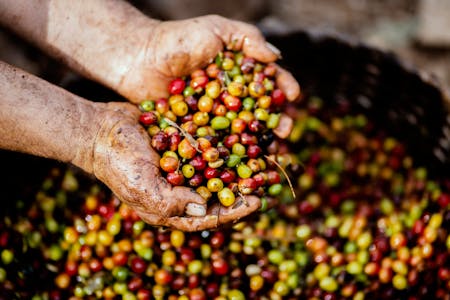
Unveiling the Journey of Coffee Beans
Written by Daniel - Sept. 6, 2023
Coffee beans are the seeds found inside the coffee cherry, the fruit of the coffee plant. These seeds undergo various processes to become the aromatic and flavorful coffee we enjoy daily. Here's a comprehensive overview of coffee beans, their origins, varieties, and journey from seed to cup.
Coffee plants thrive in the "Bean Belt," a region along the equator between the Tropics of Cancer and Capricorn, where conditions like climate, altitude, and soil are ideal for cultivation. The two most economically significant species are Coffea arabica and Coffea canephora (Robusta).
Arabica, believed to be one of the first cultivated species, accounts for about 60% of global production. Grown at altitudes between 500-2,500 meters, Arabica beans are oval-shaped with a pronounced center crease. They are prized for their complex flavors, including notes of fruits, florals, chocolate, and nuts, and have a sweeter, softer taste with higher acidity.
Robusta, on the other hand, is grown at lower altitudes up to 1,000 meters and is known for its deeper, stronger flavor with tones of wood or burnt rubber. Robusta beans are smaller, rounder, and paler than Arabica, with a less pronounced crease. They have a higher caffeine content and are often used in espresso blends for their rich flavor and crema.
The coffee cherry takes about 9 months to mature fully, changing color from green to bright red, orange, or yellow. Inside each cherry are typically two seeds, known as "beans," which are extracted through various processing methods, including wet, dry, or semi-dry methods.
After processing, the green coffee beans are roasted, a crucial step that brings out their unique flavors and aromas. The roasting process causes chemical reactions that transform the beans' physical and chemical properties, resulting in the characteristic brown color and rich aroma we associate with coffee.
The degree of roasting, from light to dark, also impacts the flavor profile. Light roasts tend to have a brighter, more acidic taste, while dark roasts are richer and more intense, with notes of caramel or even a slight bitterness.
Coffee beans' flavor is influenced by various factors, including the species, growing region, altitude, processing methods, and roasting techniques. This diversity contributes to the vast array of flavors and aromas available in the coffee world, making each cup a unique experience.
In summary, coffee beans are the seeds that undergo a remarkable journey from the coffee plant to our cups, with each step – cultivation, processing, roasting – playing a crucial role in shaping their distinct flavors and aromas. By understanding the origins and varieties of coffee beans, we can appreciate the complexity and craftsmanship behind every sip.
Sources:
https://www.ncbi.nlm.nih.gov/pmc/articles/PMC4045301/
https://www.nescafe.com/gb/coffee-culture/knowledge/coffee-beans
https://essense.coffee/en/coffee-the-journey-from-the-seed-to-your-cup/
Comments:
Daniel May 7, 2024, 8:44 a.m. wrote:
test
Daniel April 29, 2024, 8:01 a.m. wrote:
ijiu
2
Log in to leave a comment